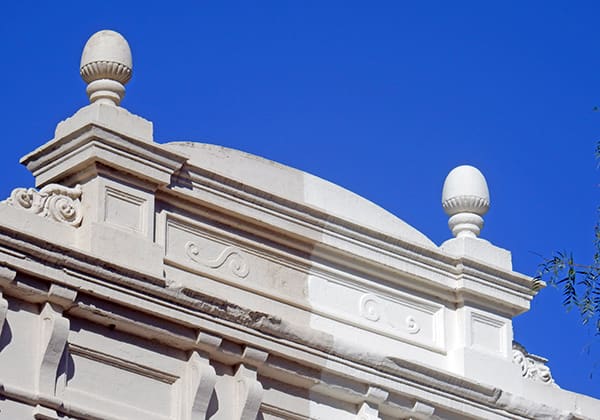I spent those first few days out of lockdown just drinking in home. It felt less like coming back from a trip away and more like waking from a nightmare, stirring in lukewarm sheets in an uneasy and overwhelming relief because it’s all okay, everything is still where it belongs.
I giddily watched the stray threads of suburbia unravel outside the carriage window on my first trip on the T2 line in five months. I have always loved this view of the inner west, of its streets crammed with a hodgepodge of architectural styles: the complex Queen Anne roofs, the eclectic pseudo-industrial condominiums. Rising above them all were my beloved Victorian terraces, stately and coquettish all at once.
Only this time, I noticed a feature on many of them I hadn’t caught before: small, rotund ornaments squatted like little demons on the corners of their roofs. Long after I disembarked that train I kept noticing them, dotted across the inner west and east. I finally found the answer on the Vanishing Sydney blog: I was looking at urns, a very strange little remnant of 1880s architectural tastes.
The use of urns as home decor stems from the Victorian fascination with dying, an interest that can be traced to the high visibility of death in 19th century England. Victorians of all classes died in their homes rather than hospitals. Death was also hardly uncommon especially for large, working class homes highly susceptible to disease. Finally, the death of the Queen’s beloved husband, Prince Albert, in 1861 cemented mourning in the public consciousness.
In other words, death was not dealt with at an institutional arm’s length as is commonplace across contemporary Western societies. It played out in private and public, on a personal and national level, encouraging lavish investment in the spectacle of death on the part of the wealthiest Victorians. This, combined with a coveting of classical antiquity, manifested in the use of urns as ornaments. Urns as an architectural feature are most commonly found in Australia on buildings completed in the 1880s.
Nonetheless, these strange little ornaments adorned in unwilting flowers and bird shit seemed ludicrously out of place in the Sydney skylines: ghosts caught in the burning light of the southern sun. They needed to be dramatically imposed against a dreary, rainy sky, not suspended in the fluttering leaves of Moreton bay figs, abruptly awoken from their eerie slumber by the screeching of cockatoos and meandering antipodean accents.
These urns began to spook me. Spotting them felt like being in a graveyard on a summer’s day I could only escape from by turning my gaze firmly to the ground. This grandiose, melodramatic allusion to the art of mourning rather than the dead themselves seemed particularly absurd when imposed on a violent and ongoing colonial project. The bitter irony of erecting fake memorials on a land where there is so much to be mourned and confronted would hardly be lost on anyone who stopped to ponder it. We as white Australians yet again marvel at the bloodless, macabre beauty of our quaint monuments, all the while continuing to deny, suppress, and erase the truth.
I can only imagine urn spotting gets weirder as the weather warms up, the bounce of the heat waves breathing unsettling life into these morbid little ornaments. Occasionally you see the stump where one has been removed in an overzealous renovation or unceremoniously rolled off in a shrieking summer storm. This does indeed spark joy. But the ones that remain have become a strange and apt record not of this nation’s past, but white Australia’s preference for imposing foreign, constructed histories in lieu of grappling with the real tragedy.






